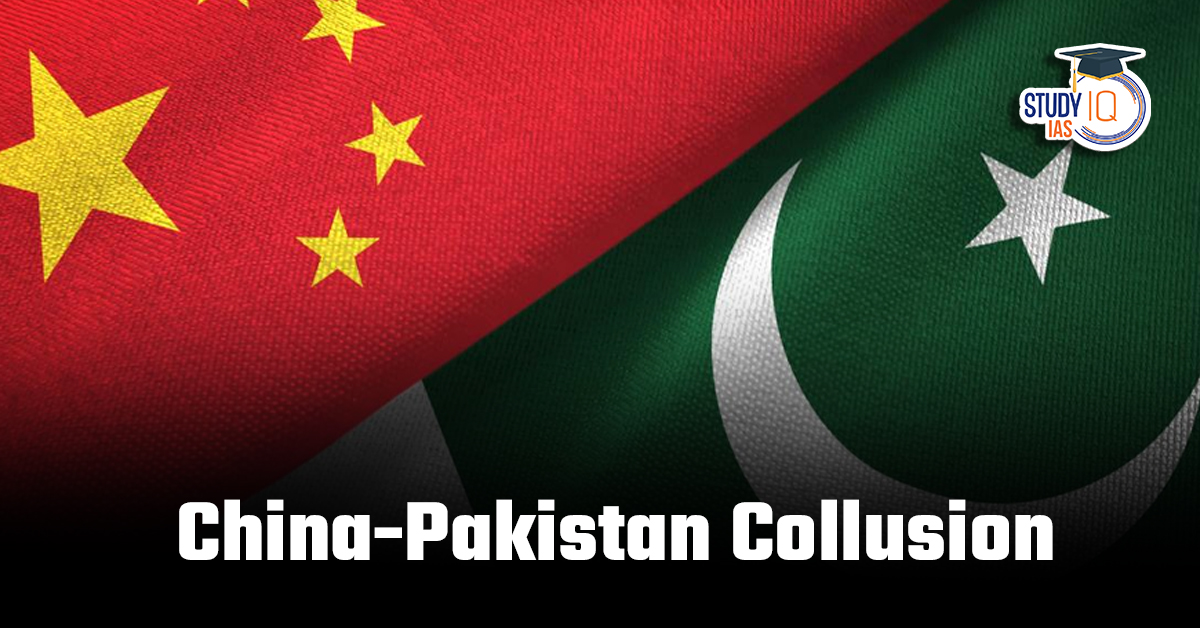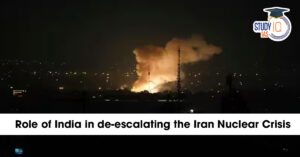Table of Contents
Context: China and Pakistan’s deepening strategic ties pose complex security challenges for India.
China-Pakistan Collusion: Deepening China & Pakistan Ties
- Defence and Military Cooperation: China is Pakistan’s largest arms supplier.
- Examples: JF-17 fighter jets (co-produced), HQ-9/P air defence system, VT-4 tanks, SH-15 howitzers.
- Ongoing talks for the supply of J-10C and potentially J-35 stealth fighters.
- Joint Military Exercises: Regular drills like “Warrior” and “Sea Guardians” (Navy) enhance interoperability.
- Technology Transfers: Support in drone warfare, satellite navigation via BeiDou, missile guidance systems, and radar technologies.
- Eg., Reports of joint development of UAVs and naval platforms.
- Nuclear and Missile Collaboration: China’s role was key in helping Pakistan develop its nuclear weapons program during the 1980s and 1990s.
- Assistance in missile technologies like the Shaheen and Ghauri series.
- China’s nuclear power plants (e.g., Chashma units, Karachi Nuclear Power Plant) have helped Pakistan’s civilian energy program.
- Strategic and Diplomatic Shielding: China has repeatedly used its veto or delay power in the UNSC to shield Pakistan-based terrorists (e.g., Masood Azhar).
- Cooperation in the Shanghai Cooperation Organisation (SCO), BRI, and G77.
- Joint opposition to India’s inclusion in groups like the NSG (Nuclear Suppliers Group).
- Economic Cooperation: Flagship project under the Belt and Road Initiative (BRI).
- ~$62 billion in Chinese investments in Roads, railways, energy, fibre optic connectivity, and the Gwadar Port.
- Give China access to the Arabian Sea, bypassing the Strait of Malacca.
- Built and operated by China, gives Beijing a logistical hub near the Strait of Hormuz.
- Potential dual-use (civilian and military) infrastructure.
- Cyber and Digital Infrastructure: Chinese tech firms like Huawei and ZTE support Pakistan’s digital infrastructure, telecom, and surveillance systems.
- Intelligence and Security Cooperation: Reports of Chinese personnel monitoring weapons use during Pakistani military operations.
- Intelligence sharing on Indian deployments and activities, especially around PoK and Ladakh.
- People-to-People and Institutional Linkages: Scholarships and cultural exchanges under Confucius Institutes and Belt and Road scholarships.
- Military officers from Pakistan trained in PLA academies.
Challenges for India
- Two-Front Military Pressure: Risk of simultaneous pressure from Western (Pakistan) and Northern/Eastern (China) fronts.
- China’s strategic support enables Pakistan to maintain a credible military threat despite economic distress.
- Strategic Encirclement: Projects like CPEC, port development in Gwadar and Djibouti, and ties with Nepal, Sri Lanka, and the Maldives increase China’s regional influence.
- Diplomatic Isolation: Sino-Pak coordination complicates India’s efforts at international forums, especially on terrorism, Kashmir, and NSG membership.
- Proxy and Grey-Zone Threats: Use of non-state actors, cyber operations, and coordinated psychological warfare make attribution and retaliation difficult.
- Economic and Technological Competition: China’s technological backing strengthens Pakistan’s indigenous capabilities in drones, cyber tech, and surveillance.
How India Can Tackle the China–Pakistan Nexus
- Military Preparedness & Modernisation:
- Integrated Theatre Commands (ITCs): For seamless coordination between services across multiple fronts.
- Surveillance and ISR: Expand indigenous satellite networks, drones, and radar systems.
- Border Infrastructure: Accelerate road and logistics development on both eastern and western borders.
- Diplomatic and Strategic Outreach:
- Engage the Global South and major powers (U.S., France, Japan) for support in international forums.
- Backchannel Diplomacy with China: Keep de-escalation channels open to avoid miscalculations.
- Strengthen ties with Central Asia, ASEAN, and Africa to balance Chinese influence.
- Technology and Cyber Resilience: Indigenise defence production via DRDO-DPSU-private sector collaboration.
- Expand capabilities in cyber warfare, AI-enabled command and control, and EW systems.
- Internal Security and Counter-Proxy Capabilities: Sharpen intelligence capabilities to counter cross-border terror and misinformation campaigns.
- Expand cooperation with Israel, the U.S., and the EU on counter-terrorism and cyber defence.
- Economic Strategy: Reduce dependency on Chinese supply chains through PLI schemes and critical mineral alliances.
- Offer alternatives to Chinese-led infrastructure in South Asia via the India-Middle East-Europe Corridor (IMEC) and the Act East Policy.


 Iran Nuclear Crisis and India’s Role f...
Iran Nuclear Crisis and India’s Role f...
 H1B Visa Program, Beneficiaries, Eligibi...
H1B Visa Program, Beneficiaries, Eligibi...
 Comparison Between India & France's ...
Comparison Between India & France's ...

























